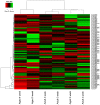Bioinformatics and Microarray Analysis of miRNAs in Aged Female Mice Model Implied New Molecular Mechanisms for Impaired Fracture Healing
- PMID: 27527150
- PMCID: PMC5000658
- DOI: 10.3390/ijms17081260
Bioinformatics and Microarray Analysis of miRNAs in Aged Female Mice Model Implied New Molecular Mechanisms for Impaired Fracture Healing
Abstract
Impaired fracture healing in aged females is still a challenge in clinics. MicroRNAs (miRNAs) play important roles in fracture healing. This study aims to identify the miRNAs that potentially contribute to the impaired fracture healing in aged females. Transverse femoral shaft fractures were created in adult and aged female mice. At post-fracture 0-, 2- and 4-week, the fracture sites were scanned by micro computed tomography to confirm that the fracture healing was impaired in aged female mice and the fracture calluses were collected for miRNA microarray analysis. A total of 53 significantly differentially expressed miRNAs and 5438 miRNA-target gene interactions involved in bone fracture healing were identified. A novel scoring system was designed to analyze the miRNA contribution to impaired fracture healing (RCIFH). Using this method, 11 novel miRNAs were identified to impair fracture healing at 2- or 4-week post-fracture. Thereafter, function analysis of target genes was performed for miRNAs with high RCIFH values. The results showed that high RCIFH miRNAs in aged female mice might impair fracture healing not only by down-regulating angiogenesis-, chondrogenesis-, and osteogenesis-related pathways, but also by up-regulating osteoclastogenesis-related pathway, which implied the essential roles of these high RCIFH miRNAs in impaired fracture healing in aged females, and might promote the discovery of novel therapeutic strategies.
Keywords: bioinformatics; impaired fracture healing; miRNA.
Figures






References
-
- Nguyen T.V., Center J.R., Eisman J.A. Osteoporosis: Underrated, underdiagnosed and undertreated. Med. J. Aust. 2004;180:S18–S22. - PubMed
MeSH terms
Substances
LinkOut - more resources
Full Text Sources
Other Literature Sources

